Method for controlling shrinkage of formed ceramic body
a technology of formed ceramics and shrinkage, which is applied in the field of controlling can solve the problems of difficult to accurately control the shrinkage of formed ceramic bodies by conventional control methods, and the shrinkage fluctuates according to the amount of time, so as to achieve accurate control and suppress the fluctuation of the shrinkage of formed ceramic bodies.
- Summary
- Abstract
- Description
- Claims
- Application Information
AI Technical Summary
Benefits of technology
Problems solved by technology
Method used
Image
Examples
example 1
[0045] A 50 l dry-type ball mill (Attritor Type-D, manufactured by Mitsui Mining. Co., Ltd.) was charged with 13 kg of partially stabilized zirconia powder (3YSE manufactured by Tosoh Corp., Y2O3: 5.15% by mass, Al2O3: 0.25% by mass, BET specific surface area: 7.0 m2 / g). The mixture was ground for 15 minutes at a rotation of 220 rpm using 120 kg of zirconia balls. As a grinding adjuvant, 15 g of oleic acid ester of polyethylene glycol (Polynon 0-44, manufactured by Tetsuno Yuka Co., Ltd.) was added. After grinding, the bottom lid of the dry-type ball mill was opened while rotating the stirring wings to take out the ground powder. The temporal response of the mass of taken out ground powder is shown in Table 1. It took eight minutes after the start of the grinding operation to take out 90% by mass of the ground powder of the partially stabilized zirconia powder put into the dry-type ball mill. The time required for taking out of the ground powder indicated in the parentheses in Table...
example 2
[0053] A 50 l dry-type ball mill (Type-D, manufactured by Mitsui Mining. Co., Ltd.) was charged with 13 kg of partially stabilized zirconia powder (3YSE manufactured by Tosoh Corp., Y2O3: 5.15% by mass, Al2O3: 0.25% by mass, BET specific surface area: 7.1 m2 / g). The mixture was ground for 15 minutes at a rotation of 220 rpm using 120 kg of zirconia balls. As a grinding adjuvant, 15 g of oleic acid ester of polyethylene glycol (Polynon 0-44, manufactured by Tetsuno Yuka Co., Ltd.) was added. After grinding, the bottom lid of the dry-type ball mill was opened while rotating the stirring wings to take out the ground powder. The temporal response of the mass of the taken out ground powder is shown in Table 3. The time required for taking out of the ground powder indicated in the parentheses in Table 3 is a relative elapse time when the time for taking out 90% by mass of the ground powder of the partially stabilized zirconia powder put into the ball mill was assumed to be 100.
TABLE 3Ti...
example 3
[0058] A 50 l dry-type ball mill (Type-D, manufactured by Mitsui Mining. Co., Ltd.) was charged with 13 kg of partially stabilized zirconia powder (3YSE manufactured by Tosoh Corp., Y2O3: 5.15% by mass, Al2O3: 0.25% by mass, BET specific surface area: 6.8 m2 / g). The mixture was ground for 15 minutes at a rotation of 220 rpm using 120 kg of zirconia balls. As a grinding adjuvant, 15 g of oleic acid ester of polyethylene glycol (Polynon 0-44, manufactured by Tetsuno Yuka Co., Ltd.) was added. After grinding, the bottom lid of the dry-type ball mill was opened while rotating the stirring wings to take out the ground powder. The temporal response of the mass of taken out ground powder is shown in Table 4. The time required for taking out of the ground powder indicated in the parentheses in Table 4 is a relative elapse time when the time for removing 90% by mass of the ground powder of the partially stabilized zirconia powder put into the ball mill was assumed to be 100.
TABLE 4Time(0-2...
PUM
| Property | Measurement | Unit |
|---|---|---|
| spherical diameter | aaaaa | aaaaa |
| time | aaaaa | aaaaa |
| time | aaaaa | aaaaa |
Abstract
Description
Claims
Application Information
 Login to View More
Login to View More - R&D
- Intellectual Property
- Life Sciences
- Materials
- Tech Scout
- Unparalleled Data Quality
- Higher Quality Content
- 60% Fewer Hallucinations
Browse by: Latest US Patents, China's latest patents, Technical Efficacy Thesaurus, Application Domain, Technology Topic, Popular Technical Reports.
© 2025 PatSnap. All rights reserved.Legal|Privacy policy|Modern Slavery Act Transparency Statement|Sitemap|About US| Contact US: help@patsnap.com



